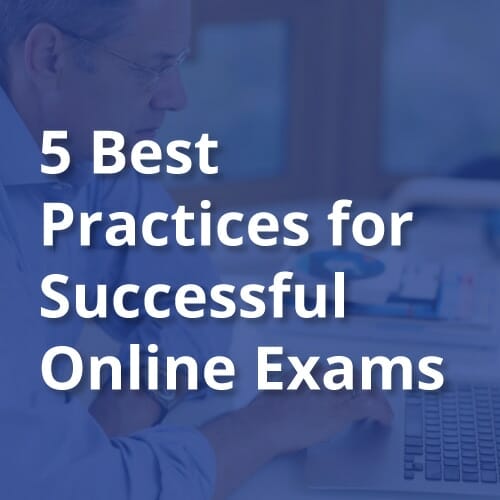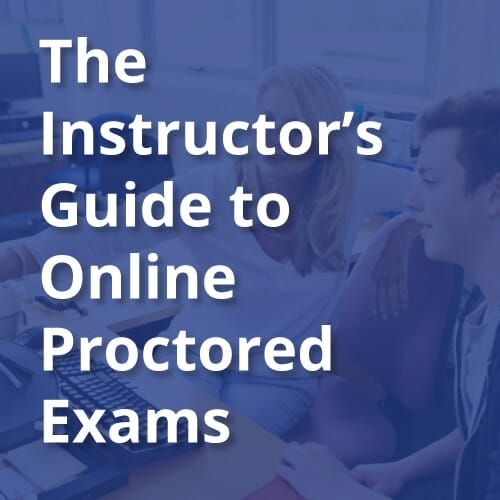Earlier this month, we sat down with two Honorlock remote proctors to hear about online exams from their point of view. Many thanks to Corey and Sa’ed for joining us to share their experiences. For more, you can read A Day in the Life of an Online Proctor. During our discussion, we asked them for their perspectives on several specific topics, including artificial intelligence.
AI is currently a hot topic for discussion and debate in educational technology and with good reason—it provides new possibilities for both online and on-campus program growth, and, when used well, can lead to higher rates of student success.
In the best cases, AI is paired with human involvement to provide the highest-quality education possible. And who better to pull back the curtain than two of the humans involved in that process?
AI in Online Proctoring
Some automated proctoring solutions rely heavily on AI. While this has benefits, including ease of scheduling, there’s also a major drawback—no live proctor is present to intervene in real-time in the case of academic dishonesty. These exams are often reviewed after the fact by proctors, but at that point, all an instructor can do is take disciplinary action. There’s no opportunity for the student to get back on track during the exam.
On the other hand, many proctoring platforms only use live proctoring. A live proctor is more able to intervene and often helps faculty feel at ease about the rigor of the testing process, but there are some drawbacks here as well. A live proctor’s attention is divided between multiple students, so they may miss an incident, and scheduling can also be a challenge for students.
Live Proctor Pop-In
Honorlock’s remote proctors (and our technology) provide the perfect hybrid between automated and live proctoring so students and schools get the best of both.
Live Pop-In means that the AI doesn’t actually make decisions about student behavior. Instead, it flags a potential incident so a live proctor can pop in to assess the situation. The AI flags common problems—like a student talking to someone else in the room—and the proctor pops in to identify what’s happening and intervene as needed.
At the same time, the human aspect helps put students at ease—they know that the system doesn’t make the final call, so they don’t have to worry as much about accidentally doing something that might create a flag (like, for instance, reading a question aloud to themselves).
How do remote proctors and AI work together?
To provide the best insight into how our AI works, we asked Corey and Sa’ed about their experiences working with it on a day-to-day basis.
Corey: Live Pop-In is our way of intervening in a student’s session to get them back on track. If the AI detects potential dishonesty, it alerts us so we can pause the exam and start a live chat with the student to address the violation and correct the behavior in a timely manner. It helps prevent academic dishonesty because we are able to intervene at the moment (often before cheating actually happens). This process also helps teach students the importance of having integrity, not only for their exams and courses but also for their professional lives after graduation.
Sa’ed: We try to prevent academic dishonesty before students even answer that first question. For instance, if we see notes during their pre-exam room scan, we can ask them to put the notes away. A student might be misinformed about the rules of their exam or may not have paid attention to the instructions. They usually comply and are able to move on with the exam as planned.
How do remote proctors benefit from artificial intelligence?
Sa’ed: The AI helps keep us informed so we can make sure we’re paying attention to all exam sessions. I don’t have to worry about a student leaving and going off camera because, if they do, the AI will alert us and we will immediately attend to the alert. This makes my role as a proctor a bit easier.
Corey: As a human proctor, I don’t have the ability to watch every single student taking an exam at once, so we use artificial intelligence to help the proctoring team monitor students. If we receive a notification that the AI has detected multiple faces in the webcam, we will prioritize our time to assess the situation and intervene as necessary. I’m honored (no pun intended!) to be part of a company that constantly innovates and improves our artificial intelligence. Our AI is a great tool, and we have a fantastic engineering team that works on it.
What is your favorite Honorlock AI feature for exam proctoring?
Corey: We have a speech detection element that transcribes what students say out loud during their exams, and it alerts us if it hears specific keywords (such as “Hey Siri” or “Okay, Google”). It really helps when we have a high volume of students testing at the same time.
Sa’ed: It’s pretty thorough at doing what it’s designed to do — from face detection to mobile phone use. If it detects a student using their phone, iPad or SmartWatch outside the view of the webcam, it alerts us. It documents exactly what the student is searching for and clicking on and their search activity is logged for the instructor to address with them.
Thanks to Corey and Sa’ed for joining us to answer a few questions about artificial intelligence and online proctoring. They’ll be back soon for one more post with exam tips to help students succeed.
For more about artificial intelligence in higher education, read Artificial Intelligence and Online Proctoring: Friend or Foe?




